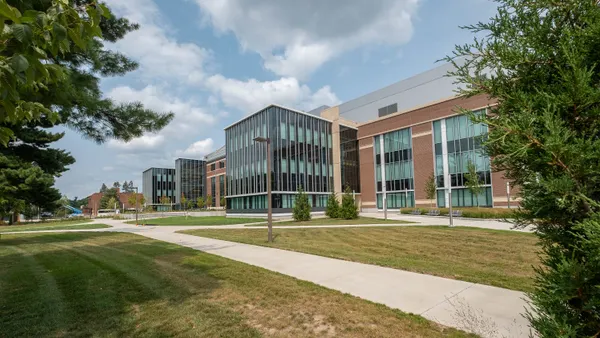Dive Brief:
-
A full-scale, prototype house currently on display at the London Design Festival showcases best-practices for reducing material waste in construction. It was designed and built by the team of Arup, Frener & Reifer, BAM Construction and The Built Environment Trust.
-
QR (Quick Response) codes are used to identify the building materials that comprise the house's structure and interior finishes. The goal is to facilitate the materials' reuse at the end of the building's life — a concept called the circular economy.
-
Open to the public from Sept. 19 to Oct. 7, the concept house features timber joists and battens, girder clamps, loose-lay carpet tiles, acoustic wall panels made from recycled plastic bottles, and mycelium-based insulation among its sustainable materials.
Dive Insight:
Construction waste management is quickly emerging as a high-impact strategy to cutting costs related to haulage and tipping while helping to improve buildings' environmental impact. According to the American Institute of Architects, between 25 and 40 percent of the U.S. solid waste stream comes from buildings, while only 20 percent of construction waste and demolition debris gets recycled.
Successful waste management plans will ultimately require better understanding among workers on the job site of which building materials can be recycled, and how. As evidenced by the concept house in London, the incorporation of QR codes onto building materials is one example of how the industry is embracing the circular economy and cradle-to-cradle design by identifying installed products that can be reused or recycled. (See other uses of QR codes in construction here.) For example, QR codes and other material identification technology can be used to help workers identify standard product sizes and optimize framing layouts.
Still to be determined is the labor and carbon impact of deconstruction versus demolition of buildings and other infrastructure, as well as that of transporting materials to new job sites or intermediary stocking locations. Napa, CA-based Watershed Materials is attempting to address the challenge with pop-up plants. The company has leveraged a $750,000 National Science Foundation grant to create a machine that produces new concrete masonry units by compressing demolition material sourced on-site. It is partnering with San Francisco Bay Area real-estate developers Westlake Urban and Alpha Group to use that process to provide building materials for a forthcoming urban infill redevelopment project in San Francisco's Inner Sunset neighborhood.











